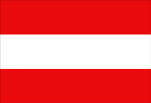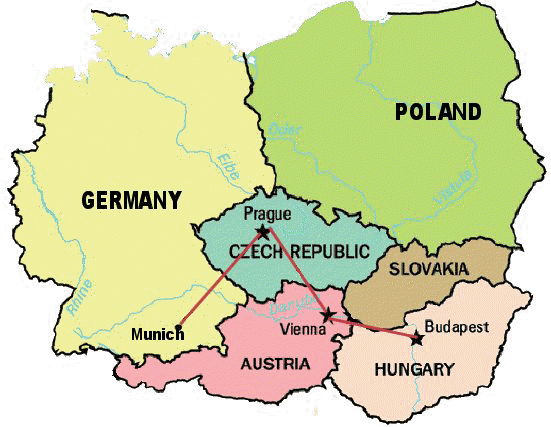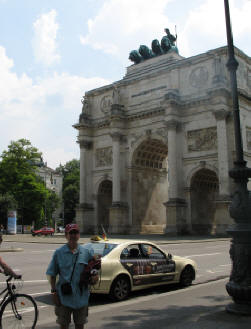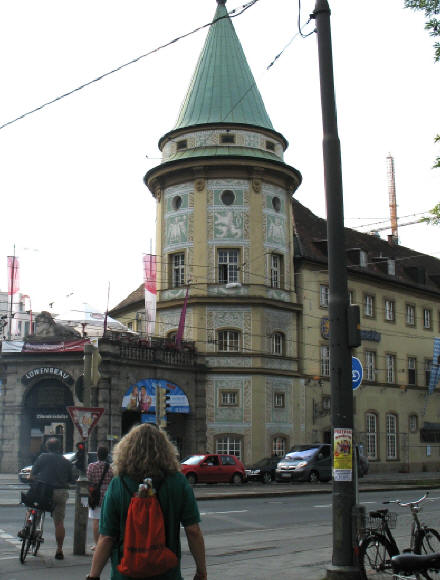 |
 |
 |
 |
|
|
Summer 2010! Four cities in Four countries |
|
|
(Each city is hyperlinked in gray) |
||
|
Munich, Germany München, Deutschland
|
 |
Vienna, Austria Wien, Republik Österreich Candle for Joey
|
| This trip was very different than our usual trips in many ways .... We visited four different countries, rode trains through spectacular county landscapes, used three different currencies, and visited sites and buildings that date from more recent history - the 16th century up to WWII. Our past trips have focused on ancient cities and cultures including Egypt, Rome, China, & Machu Picchu. On this trip it was absolutely fascinating to see buildings that were centuries old and had been burned, bombed, or occupied in times of war - over and over again - then restored to their former glory. Our latitude was higher than that of Virginia - so we had to get use to the sun coming up at around 5:00am and setting at around 9:00pm. It made the concept of sleeping late and going to bed early bizarre. Our first day we were up with the sun and had to wait four hours for even the first coffee stands to open. |
|
When we arrived in Munich, Germany we headed off
to the
Hotel
Alfa |
||
|
|
|
|
|
Our first stop was the Frauenkirche or Dom zu Unserer Lieben Frau (Cathedral of Our Dear Lady). We forgot to take a picture of it from the outside, so the first image is from Wikipedia. It was started in 1468 and took only twenty years to complete. The ceiling is 102 feet high, and it seats 20,000 people. Kimi and Kini are looking at "The Devil's Footprint". From this spot in the church, it is impossible to see any of the magnificent stained glass windows. Legend has it that while the church was being built, the devil would stand here and laugh at the builder for building a church with no windows. When he found out that there were windows, he stomped his foot so hard it left this imprint. |
||
|
|
The Marienplatz (on the right) has a tower called the Glockenspiel where at 11am 43 bells and 32 life-sized figures reenact famous stories in German history. Take a look on YouTube. The Karlsplaz Fountain was a nice relief from the summer heat. |
|
|
Kini & Kimi had a great time climbing up on the head of this gargoyle. Many of these are built as downspouts when it rains. |
|
|
|
|
|||
|
|
|
The next morning we went on a hop-on
hop-off tour which means you get a wristband and can get on and off the
bus at any stop, any time. In the first picture, K&K and Bob have found a
seat on the top level.
Behind Amy is the Theatine Church in the Odeonsplatz. |
|
We hopped off at the Nymphenburg Palace (Schloss Nymphenburg) and spent most of the rest of the day there. The palace was started in 1664 as a summer retreat for the King and court. It was added onto for over a century. The grounds cover over 490 acres with "small pavilions" (meaning one and two-story buildings) scattered throughout the gardens. |
||
|
|
|
|
|
There were frescos on the ceilings and walls everywhere. Golden statues and gilded furniture decorated every room. One hall showcased incredible and intricately carved sleds and coronation coaches. |
||
|
|
|
|
|
|
|
One of these pavilions
is the Magdalenenklause. The cracks in the walls and chipped
plaster on the outside of the building was done purposefully. The designer
wanted it to look like it was in ruins to symbolize the transience of man
and to inspire meditation.
The inside walls and ceilings are mosaics of colored stones and natural seashells. Over a very simple alter are beautiful frescos. |
|
|
|
 |
|
|
|
 |
 |
We hopped on the bus again at the Siegestor (Victory Gate). Its style is very reminiscent of the Arc de Triomphe in Paris. The inscription reads: "Dem Sieg geweiht, vom Krieg zerstört, zum Frieden mahnend", or "Dedicated to victory, destroyed by war, reminder of peace". We had a lovely stroll through the Englischer Garten or English Garden. It is larger than Central Park in New York. We took a picture of two of the band members as they took a break from playing traditional music in the Chinesischer Turm or Chinese Tower (a five story wooden pagoda). |

|
|
 |
c top d
|
In the morning we left for Prague (Praha)
on what we now fondly call the Prison Train. |
c top d
|
We arrived in Prague, Czech Republic
(Praha,
Česká
Republika) fairly late in the day and checked into the
Hotel
Elite. We thought it was kind of odd that we had to fill out so much
paperwork to register and that the staff kept asking questions and such.
But, it all made sense when we opened the door to our room. Today was July 1st - our 27th wedding anniversary - and our entire family from Virginia and Colorado had contacted the hotel to surprise us! We thank each of you!
We found a delightful restaurant right around the corner called Restaurace U Seminaristy. A little alley way leads to a small outdoor square, trellised with vines and shading umbrellas. The menu had over 150 items on it and was 43 pages long - partially due to the fact that each item is described in three languages. To take a look for yourself, click here (.doc). The food and atmosphere were fabulous! |
||||||
|
||||||
|
|
|
|
||||
|
We decided to visit the Prague Astronomical Clock Praský Orloj first. It is an amazing structure! The lower circle shows which month it is. The second clock dial (blowup on right) is the astronomical clock - it shows the position of the moon and sun in the sky and other information. Above it are two windows that show "The Walk of the Apostles". Every hour the windows open and figures circle past the windows. Amazingly, it dates to 1410! |
 |
From the top of the clock tower were had an excellent view of all Prague. Churches, castles, monuments, and the city itself, all beautiful! A tourist passed us and said, "Shoot,
I forgot to pack my UVA shirt!" |
 |
 |
 |
 |
|
In Prague, we rode the funicular up the hill side to Castle Hill. K&K loved it, as did we. The views were amazing! At the castle's entrance we found the palace guards and had to go there with a picture. |
||
 |
Saint Vitus'
Cathedral (Katedrála
svatého Víta) on Praugue's Castle Hill. http://en.wikipedia.org/wiki/St._Vitus_Cathedral According to Wikipedia it is the biggest church in the country. The foundations date to 964, but additions and reconfigurations were built on top of original foundations, then added to and restructured over centuries. Interestingly, we found that not a single church of any denomination had a place to light a candle. Humm... Maybe our next country! |
|
 |
 |
 |
|
|
Church of Our Lady Victorious houses the Infant Jesus of Prague or il Bambino di Praga. This was by far the most bizarre religious icon we have ever seen. It is a little wax doll housed in a marble nave with golden gilded statues and details surrounding it. Spanish in origin, it dates to the early 1500s. It has over 380 different spectacularly embroidered outfits that may only be changed by the nuns. One of the outfits was made and embroidered by Empress Maria Theresa. There is even a museum upstairs that displays some of its robes!
|
c top d
|
Our next train was from Prague (Praha)
to Vienna, Austria (Wein, Republik
Österreich). This train ride was an hour less at just under five
hours, and wonderfully comfortable. The windows opened, there were no
compartments, and we sat with a
young man from the States studying chemistry |
c top d
|
Again, after we got off the train, we checked into our hotel - this time the Delta Hotel in Vienna, Austria which is a grand city. This was a one day exploration - the train arrived late in the day, dinner, sleep, and up early to explore as much as possible in 24 hours. Out next train would leave early the next day. |
|
|
|
First stop, the Schönbrunn Palace (Schloss
Schönbrunn). No pictures were allowed inside, but the palace was
awesome! Schönbrunn means "beautiful spring", because of the
artesian well that provided water to the court.
Roman ruins, beautiful out buildings, huge grounds, and the main complex is said to be more than four times the size of the Vatican complex. |
| We wanted to light a candle in memory of Joey
who we met on our trip
to Greece and, to our great sadness, died a few weeks after returning
home. This church seemed like the perfect place.
As we lit the candle, a little boy came in with his mother singing "Happy Birthday to You" in English. His mother kept trying to apologize to in a whisper to all around, "I told him that we were going to see a place where Jesus was honored as being born again. I guess he thinks of it as a birthday party." Hey, mom, he's right! Out of the mouth of babes. :) Made lighting that candle for Joey so much more joyful and meaningful! When we walked out, we knew that this was the right church and the right time - Joey in heaven smiled - there was a halo above the church steeple. We knew he was there with us. |
 |
|
 |
 |
A visit to the
Hofburg Palace was simply enchanting. Pictures were
restricted. But we learned about the Lipizzoan horses that are so
intelligent and will dance under their riders. Black as foals, white as
adults, they horses ar the gem of Austria.
On the right, K&K are the little spots in the guard tower leading to the palace complex. |
 |
 |
|
|||||||
c top d
|
The final train we took was from
Vienna to Budapest, Hungary (bʊdəpɛt, Magyar Köztársaság).
Trying doors, running, trying the next door, running - and then it happened - Amy turned back to see where Bob was, and down she went - full speed with bags flying. We grabbed everything up and kept going. Made it through the door with maybe 20 seconds left! Nothing more than scrapes and bruises on hands, knees, and elbows - but it hurt! Fortunately, we had the next four hours to rest. :) |
c top d
|
Our final hotel was the Carlton Hotel, Budapest, Hungary (bʊdəpɛt, Magyar Köztársaság). Buda and Pest are two cities on each side of the Danube River. Our hotel was located on the Buda side, in a quiet and relaxing area. After checking in, we decided to take a short walk over the Chain Bridge (Széchenyi lánchíd) to the shopping area. We found wonderful small gifts to bring home, including a master class parachuting medal for Bob. |
|
|
|
|
Behind Bob, on the far left, is the Parliament building (Pest side). Behind Amy is one of the stone lions that grace each side of this suspension bridge that opened in 1849. Budapest is a city of being blown up or burnt down over centuries. In WWII, during the Siege of Budapest, the bridge was bombed and severely damaged. The Chain Bridge was rebuilt and reopened in 1949. Below, K&K rest in the shade to have their picture taken too. In the morning we took a short walk from our hotel on the Buda side to the funicular (a cable car that is pulled up and lowered down a steep grade). It is the brown stripe in the middle of the picture below. Unfortunately, it wasn't running when we got there, so we had to hike up the big hill to the Buda Castle (Budai Vár) and Castle District. |
|
 |
 |
 |
On the left, and after a pleasant but long walk, we looked back over the Danube toward Pest and the Parliament Building. We arrived early before the buildings were open and the tourists swarmed. It was quiet and cool. The Matthias Fountain (Mátyás-kút) shows King Matthias Corvinus, his hunting party, and animals. Amy and K&K are standing in front of the lions that guard the entrance to the Royal Palace Court Yard. |
|
|
|
|
The Matthias Church (Mátyás-templom) was built in 1015. The roofing tiles we gorgeous tones of orange, yellow, and gold. The interior was spectacular. |
||
|
|
|
 |
 |
To the left is the back side of Matthias Church with the tiled roof. The Fisherman's Bastion above (Halászbástya) is a courtyard beside the Matthias Church. It was another area that was almost completely destroyed during WWII. And yes, it was used as a fish market in the past. While there, we had a young gentleman say to us, "Shoot, I forgot to wear my UVA t-shirt!" He was from Charlottesville and loved our Hokie garb. |
| "The sculpture of a Turul bird just outside
the cable car station is not, as you might think, an eagle, but the
mythical turul bird (which is believed to be a kind of falcon). This bird
is a part of the story of how the Magyars settled the Hungarian homeland.
This bird appeared in a dream to the wife of the Magyar leader Ügyek and
told her that she would be the founding mother of a new nation." From: http://wikitravel.org/en/Budapest/Castle_Hill |
 |
|
|
|
|
|
The Labyrinth of Buda Castle (Budavari Labirintus) was fun, but a bit geeky. We arrived early, before any tourists, which made it a lot more fun. There wasn't much explanation as to what the labyrinth was originally, but now it is just a bunch of tunnels that have everything from recreated stone age drawings from the area to items that people might dig up from our present culture. In one spot was a cave with a four-sided fountain covered in vines with wine flowing continuously. A sign warned you not to drink the wine (yuk!), but the aroma was enchanting. |
||
|
|
|
 |
|
The Hospital in the Rock (Sziklakórház) was built as a WWII military hospital (1939 - 1945). In 1958 to 1962 during the Cold War it was expanded and hardened as a nuclear bunker as a top-secret project. The tour guide said that oil was delivered to the bunker via a pipe hidden under a flower garden in the castle area. This worked well until winter came, then they had to simply truck it in during the night. It was a bit hard to find (the entrance was outside the castle walls) and English tours are only at certain hours, but it was well worth going. We recommend clicking on the link above to read more about it. |
|
|
|
 |
Had to take a picture of a typical menu
- click on it to see the full page. Included in the fare was:
Small smoked knuckle slices And then there was chicken and fish too (thank God!) Bob liked the rabbit - Amy stuck with chicken shish kabobs. |
|
|
Hungarian Parliament Building (Országház) The picture on the left is from the back side - the tour entrance. The front side is much more impressive. The interior was fabulous - a vaulted dome, the crown and scepter, and a scale model made of match sticks. Indeed, this city was the first to invent a technique to make imitation marble. Before WWII, the builders took out many of the windows and stored them in the basement under sandbags so that they would not be destroyed by the bombing. |
|
|
|
|
|
|
The Crown Jewels were stolen, recovered, stolen, and recovered over centuries by different warring factions and countries. The U.S. 86th Infantry Division recovered them in Mattsee in 1945 and eventually gave them to the American Army so that they would be safe from the Soviet Union during the Cold War. The U.S. took them to Fort Knox, Kentucky to store them. They were returned to the Hungarian people in 1978 by Jimmy Carter. |
|
|
|
Below are pictures from St. Stephen's Basilica (Szent István-bazilika) which was named for King Stephen (the first King of Hungary, 9751038). As beautiful as it was from the outside, the inside was simply stunning! |
|
|
|
|
|
And then we found out what why this church was so revered by the Hungarian people. It had a relic. No, not just a relic - it had the Chapel of the Holy-Right Hand (Szent Jobb-kapolna). Yes, we kid you not, the mummified right-hand - the "incorruptible right-hand" - of the King is housed in this church draped with pearls and jewelry. Then we got to do another tower. But this one was cool - it took us to the inside of the structure of the dome and had scaffolding we crossed to get to the outside surround. A chilly day, we had to have our sweaters, and the wind on top was really blowing - but the views were priceless. |
||
|
|
|
|
|
Dohány Street Synagogue The second largest synagogue in the world, Dohany seats just under 3,000 people (1,492 for men and 1,472 in the women's galleries). When we entered, Bob was given a kippah (plural - kippot), the cap men wear to show respect and to remind them of the presence of God. Many wear them all the time as a pious act (midat chasidut) - believing that they are never outside of the presence of God. They didn't have one small enough for Kini and his youngin' but they knew he was covered in the spirit. The Synagogue also houses the Jewish Cemetery in the courtyard where over 2,000 were buried after the tragic events of WWII where the Jewish people congregated and died in 1944-1945. |
|
|
|
c top d
|
The trip home was uneventful. We met some wounded soldiers returning from combat on our plane. We said thanks, our deepest thanks for their service. Mom had a roast for us, Jenny had stocked the fridge and done all sorts of chores for mom while we were gone, and Cooper checked in from Colorado on a regular basis. We love our family! Toby and Athena did well with the critter sitters and Jen/Tiki/Mom came and played with them while we were gone. Thank you New River Valley Varmints Pet Sitting Agency! |
c top d
Back to Kini & Kimi's Home Page
Return to Bob & Amy's Home Page